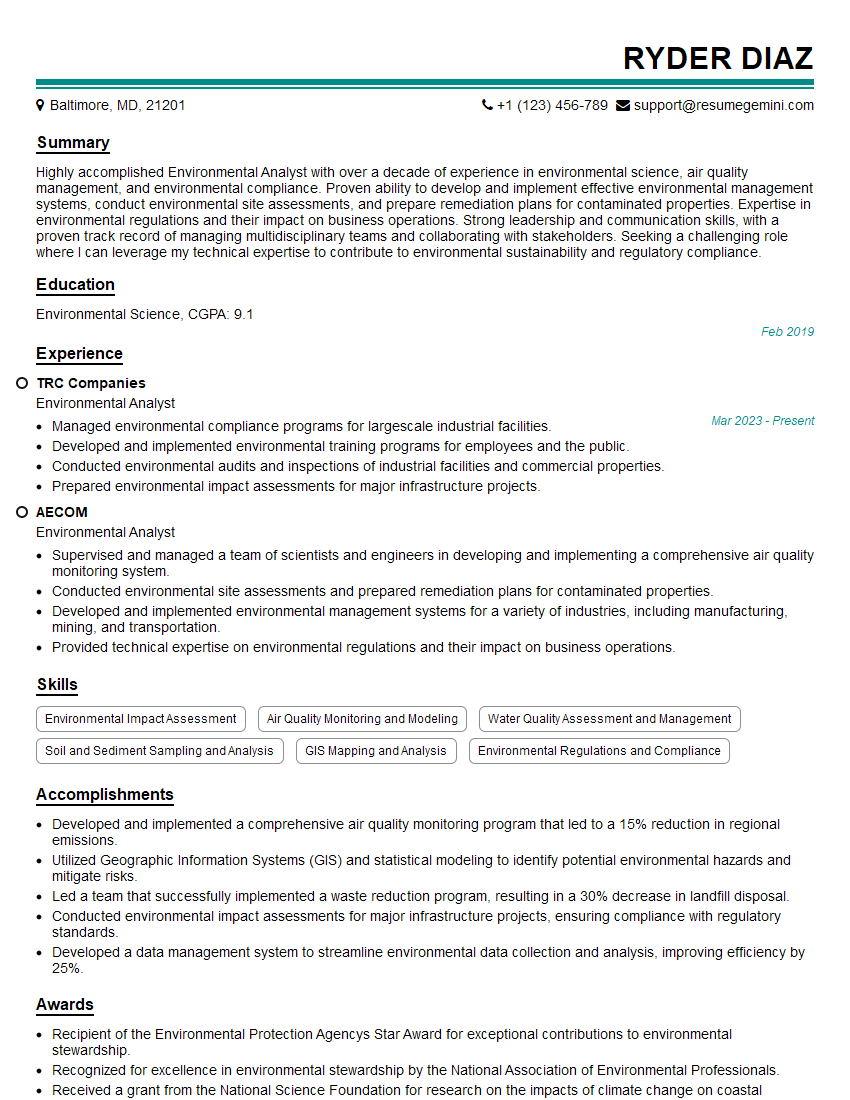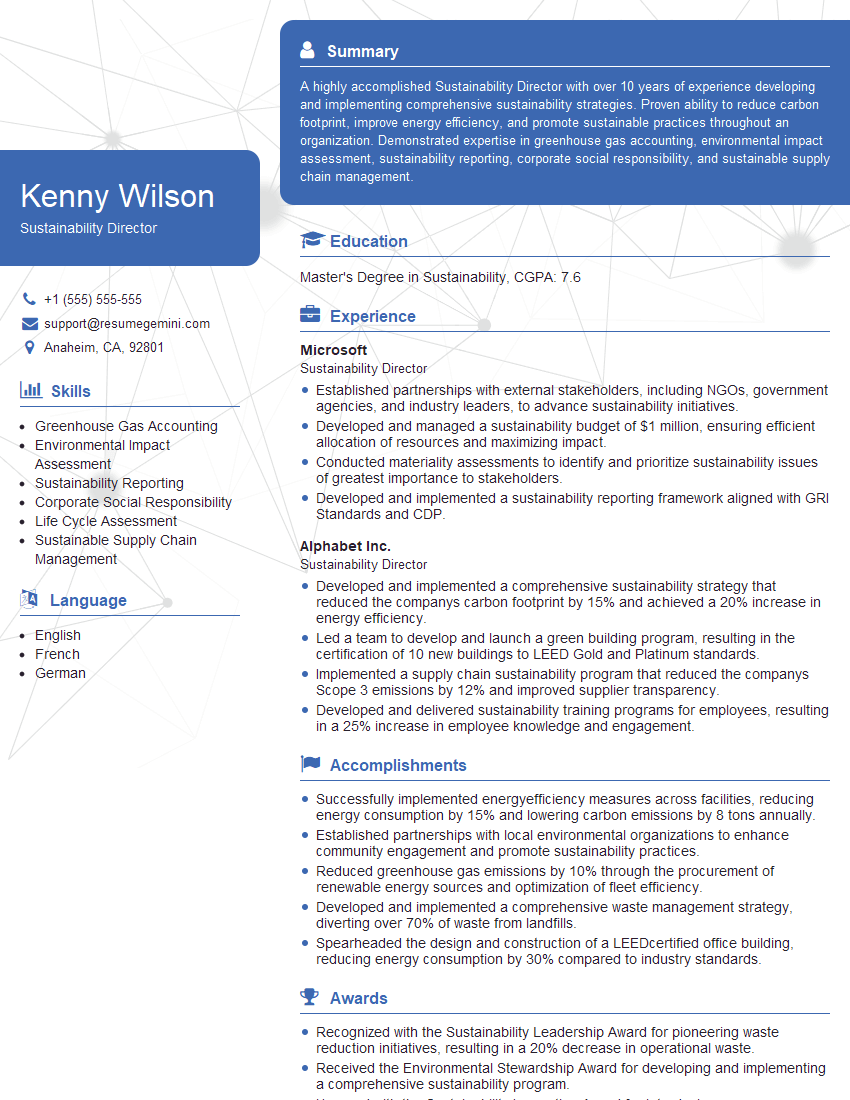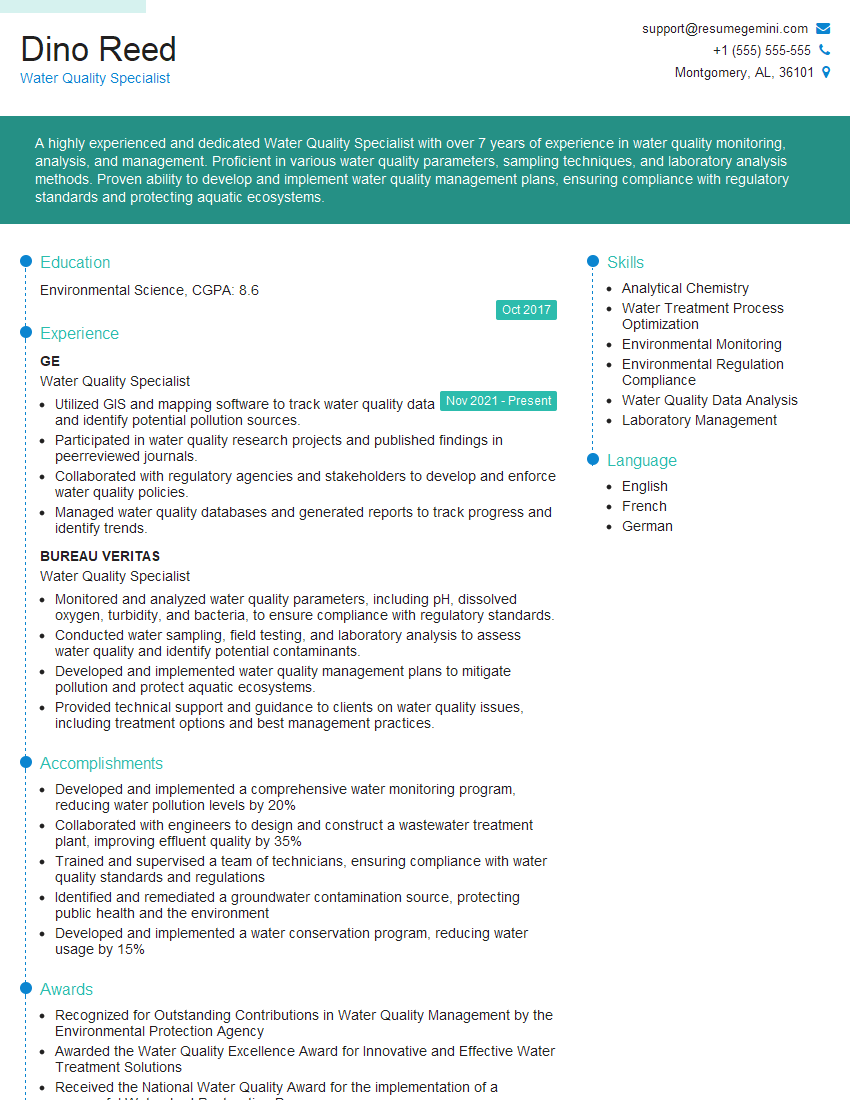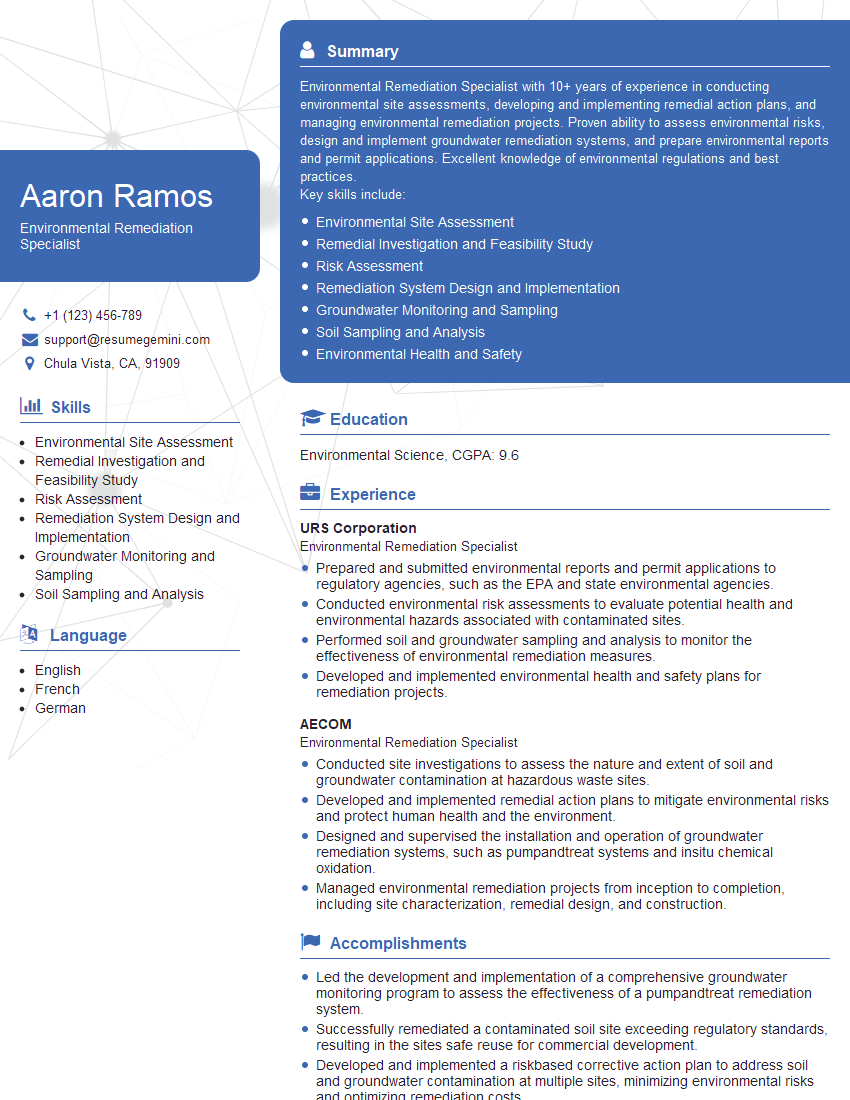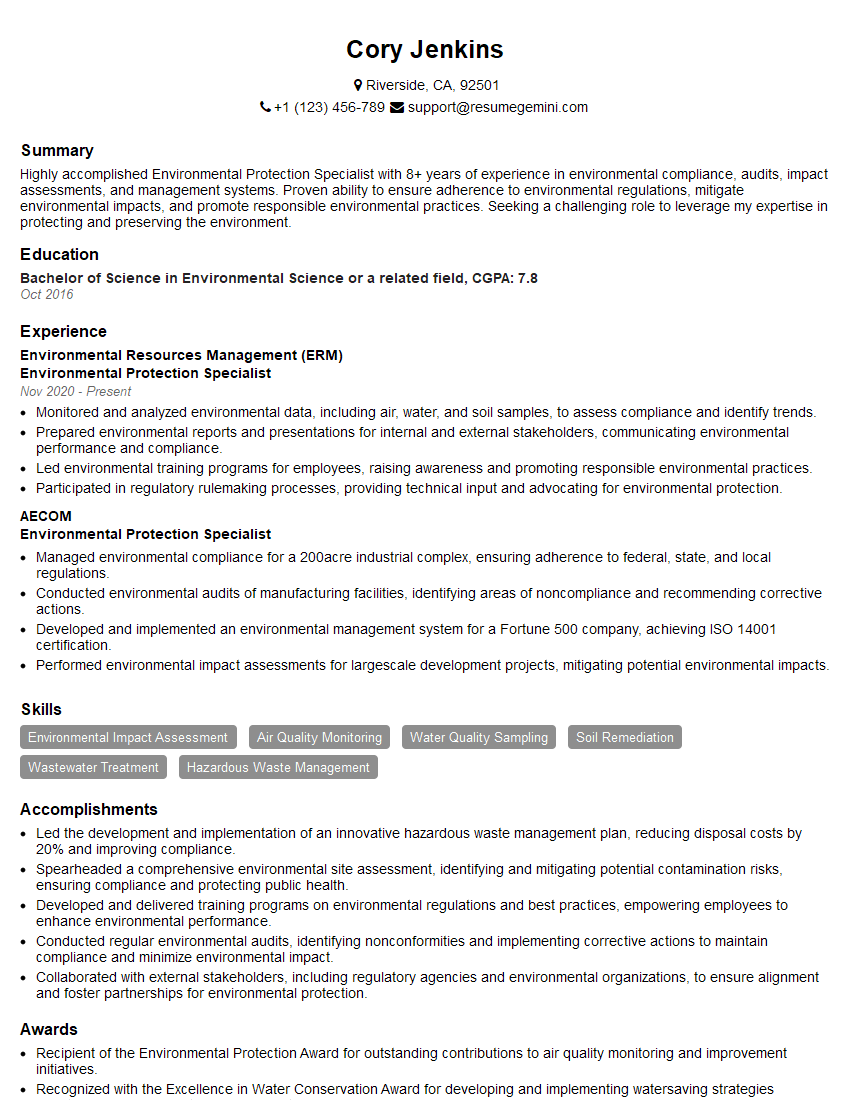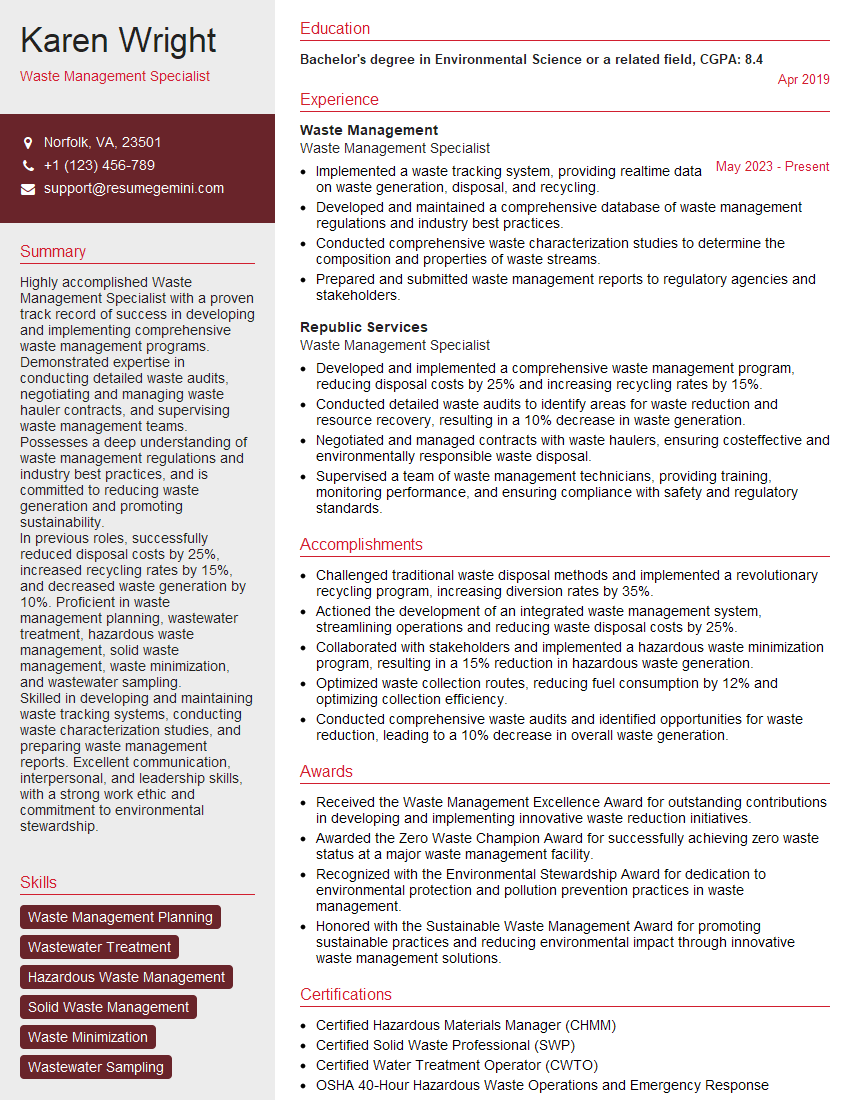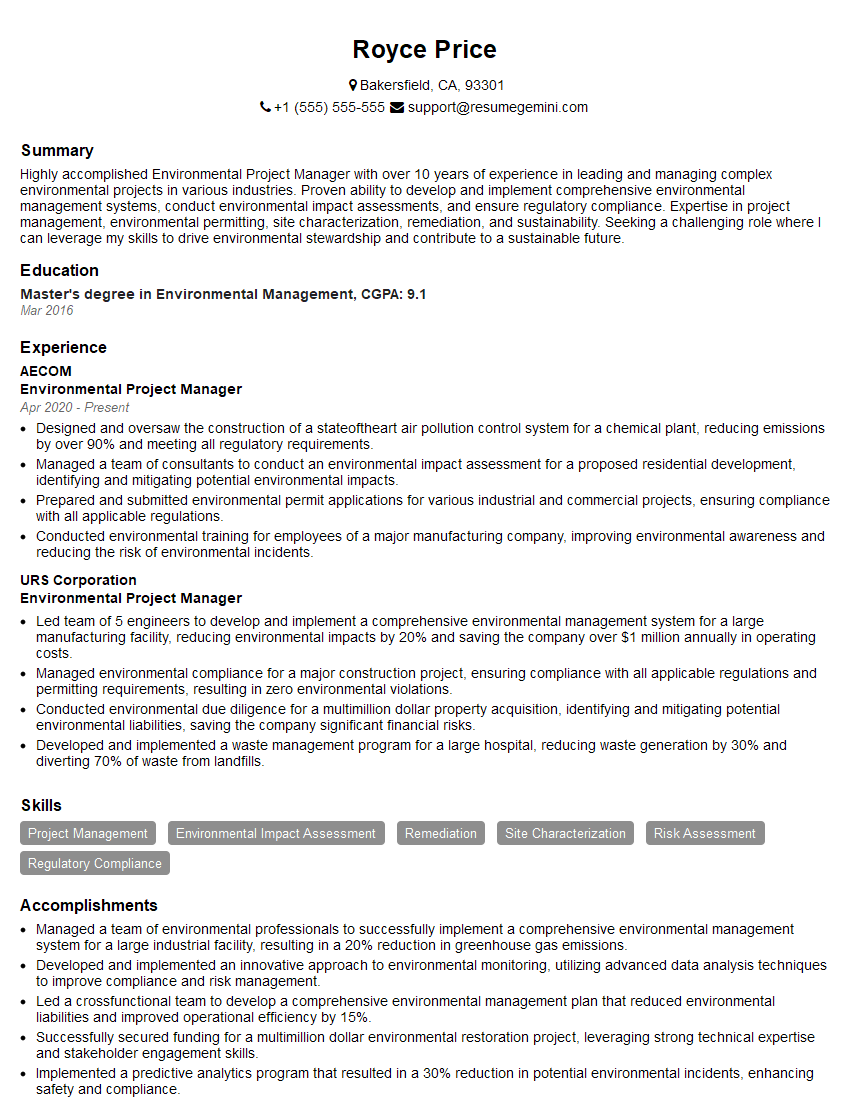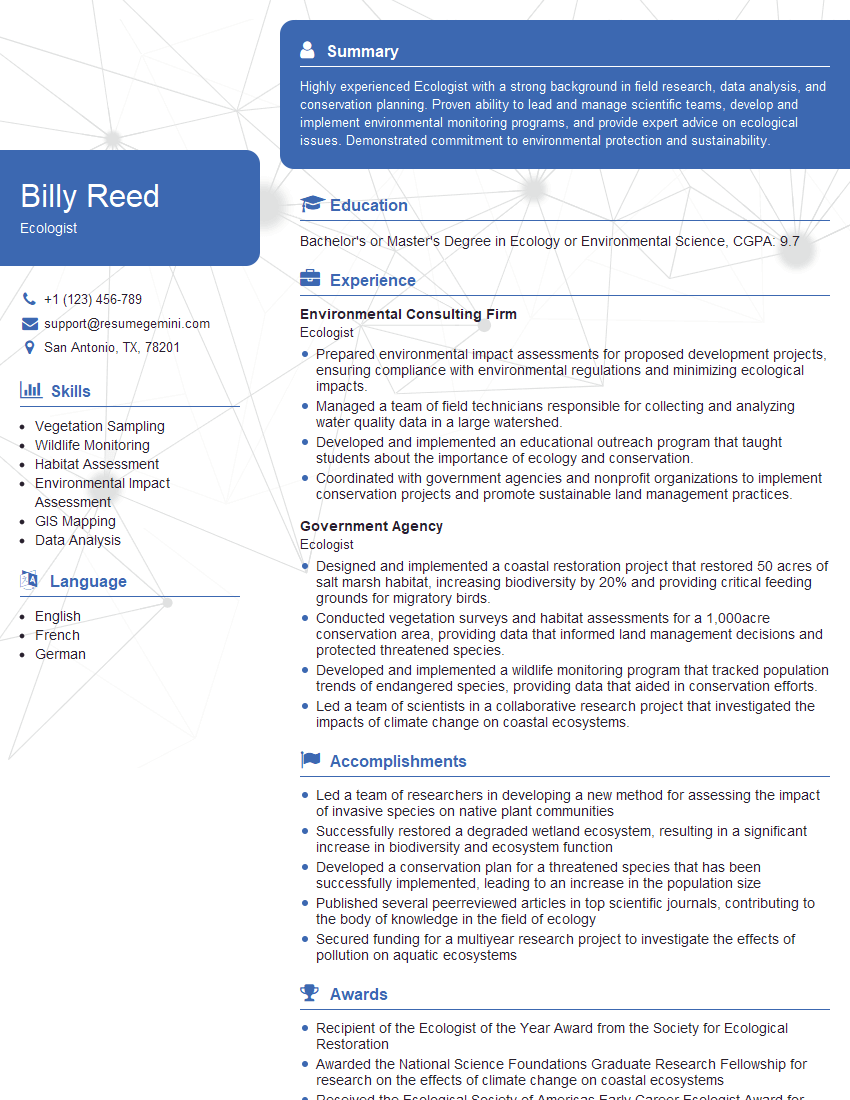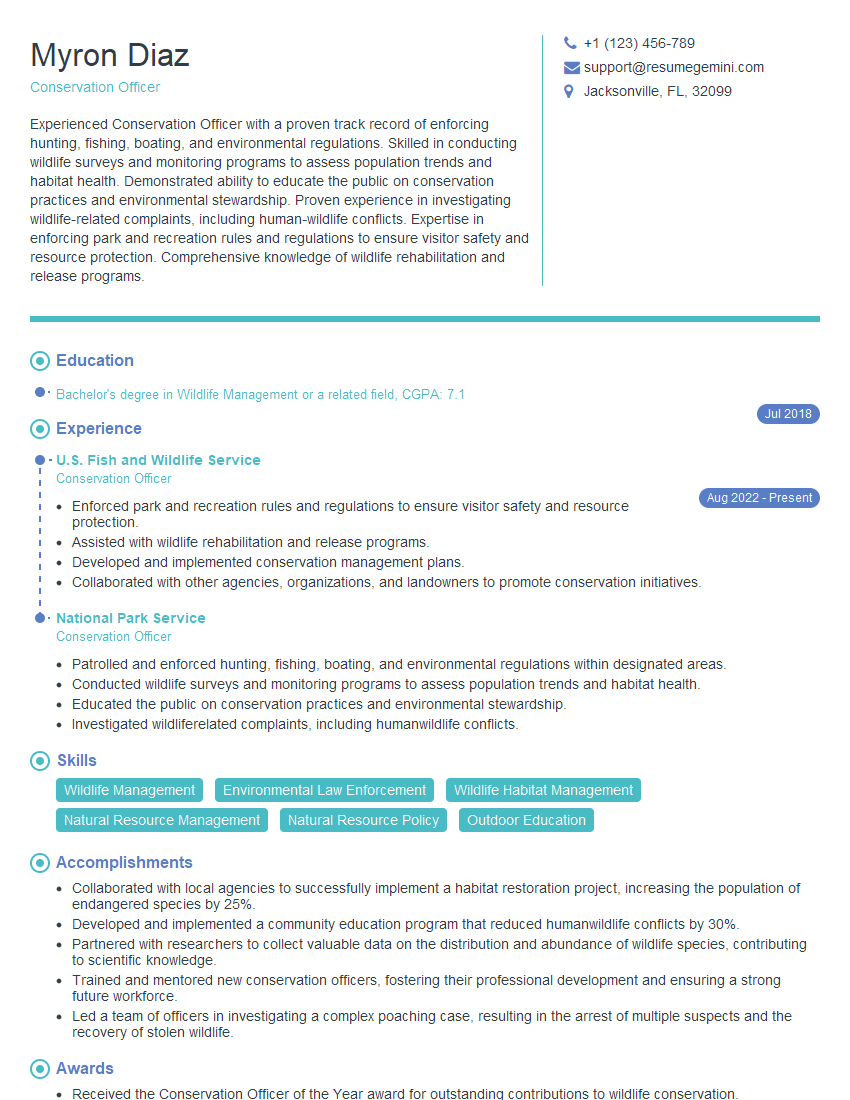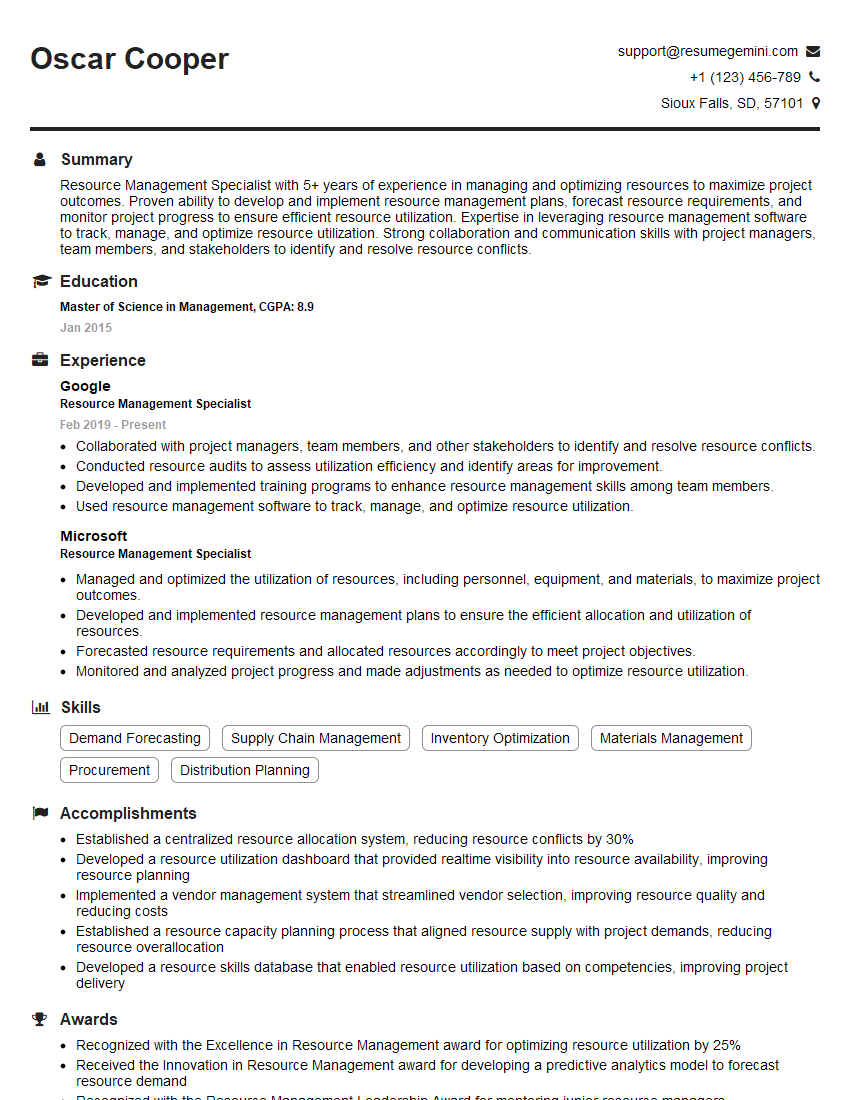Cracking a skill-specific interview, like one for Environmental Protection and Stewardship, requires understanding the nuances of the role. In this blog, we present the questions you’re most likely to encounter, along with insights into how to answer them effectively. Let’s ensure you’re ready to make a strong impression.
Questions Asked in Environmental Protection and Stewardship Interview
Q 1. Describe your experience with environmental impact assessments.
Environmental Impact Assessments (EIAs) are crucial tools for predicting and evaluating the likely environmental consequences of proposed projects. My experience spans over a decade, encompassing a wide range of projects from large-scale infrastructure developments like highway construction and wind farms to smaller-scale initiatives such as residential developments and industrial expansions.
In my work, I’ve followed a structured approach, typically starting with scoping the assessment – defining its boundaries and the key environmental aspects to consider. This is followed by baseline data collection, using methods like ecological surveys, water quality monitoring, and air quality measurements. Next, I model potential impacts using appropriate tools and techniques, considering both direct and indirect effects, as well as cumulative impacts from other existing activities. Finally, I develop mitigation strategies and assess the effectiveness of those strategies in minimizing adverse environmental impacts. I’ve presented my findings in comprehensive reports, providing recommendations for project design modifications and environmental management plans. For example, in a recent highway project, my EIA identified potential impacts on local bat populations. By recommending changes to the lighting design and construction scheduling, we successfully mitigated those risks.
Q 2. Explain the principles of sustainable development.
Sustainable development rests on three core pillars: environmental protection, economic growth, and social equity. It’s about meeting the needs of the present without compromising the ability of future generations to meet their own needs. This means balancing the exploitation of natural resources with their conservation, ensuring economic progress is inclusive and equitable, and protecting the environment for future generations.
Imagine a farmer who practices sustainable agriculture. They might use crop rotation to maintain soil fertility (environmental), invest in efficient irrigation systems to reduce water use (economic), and provide fair wages to their employees (social). This integrated approach ensures long-term viability and prosperity. Similarly, a city might implement a robust public transport system, reducing reliance on cars (environmental), while creating jobs in the transport sector (economic) and improving accessibility for residents (social).
Q 3. What are the key regulations governing air pollution in your region?
The key regulations governing air pollution in my region (assuming a hypothetical region with regulations similar to many developed countries) are complex and multifaceted. They typically involve a combination of national and regional legislation and policy. These include:
- National Ambient Air Quality Standards (NAAQS): These set limits for various pollutants like ozone, particulate matter, carbon monoxide, sulfur dioxide, and nitrogen dioxide. They define acceptable levels of these pollutants in the air to protect public health and welfare.
- Emission Standards for Stationary and Mobile Sources: These standards regulate the amount of pollutants released into the atmosphere from industrial facilities, power plants, and vehicles. This often involves the use of pollution control technologies and permits.
- Air Quality Monitoring Networks: Extensive monitoring networks track air quality, providing data to assess compliance with NAAQS and to identify pollution hotspots.
- Enforcement Mechanisms: Agencies are responsible for enforcing compliance, using penalties and legal action for violations.
Specific regulations can vary considerably depending on the region’s unique environmental conditions and industrial activities. Understanding these regulations is vital for responsible environmental management and compliance.
Q 4. How do you monitor and mitigate water pollution?
Water pollution monitoring and mitigation require a multi-pronged approach. Monitoring usually starts with identifying potential sources of pollution, such as industrial discharges, agricultural runoff, and sewage overflows. We use a variety of techniques, including water quality sampling and analysis, to measure key parameters like dissolved oxygen, pH, nutrient levels, and the presence of harmful chemicals or pathogens. This data informs our understanding of the extent and nature of the pollution.
Mitigation strategies depend on the sources and type of pollution. For point-source pollution (e.g., industrial discharges), the focus is on implementing best management practices (BMPs), upgrading wastewater treatment facilities, and enforcing regulations. For non-point source pollution (e.g., agricultural runoff), strategies might involve promoting sustainable agricultural practices, such as buffer strips along waterways, and implementing erosion control measures. Public awareness campaigns and community engagement play a significant role in mitigating pollution.
Q 5. Describe your experience with waste management strategies.
My experience with waste management strategies covers a range of approaches, from reducing waste generation at the source (source reduction) to recycling and composting. I’ve worked on projects that have involved developing comprehensive waste management plans for municipalities and industries. These plans typically outline strategies for waste reduction, reuse, recycling, and disposal, aiming to minimize environmental impacts and maximize resource recovery.
For example, I helped a manufacturing company implement a zero-waste initiative. This involved analyzing their waste stream, identifying opportunities for waste reduction and reuse, and implementing new recycling programs. We also worked on optimizing their material sourcing strategies to minimize packaging waste and prioritize recycled materials. The result was a significant reduction in landfill waste and improved resource efficiency.
Q 6. Explain the concept of carbon footprint and its reduction.
A carbon footprint represents the total amount of greenhouse gases (GHGs) generated by our actions, whether directly or indirectly. It includes emissions from energy consumption, transportation, deforestation, and industrial processes. Reducing our carbon footprint is essential to mitigating climate change.
Strategies for carbon footprint reduction focus on decreasing GHG emissions and increasing carbon sequestration (absorbing CO2 from the atmosphere). This can involve switching to renewable energy sources (solar, wind), improving energy efficiency in buildings and transportation, adopting sustainable transportation methods (walking, cycling, public transport), promoting sustainable land use practices (reforestation), and investing in carbon offsetting projects (e.g., supporting reforestation efforts).
For instance, a company might reduce its carbon footprint by switching to LED lighting, installing solar panels, and investing in electric vehicle fleets. Individuals can reduce their footprint by consuming less energy, choosing sustainable food options, and flying less.
Q 7. How do you assess the environmental risks associated with a project?
Assessing environmental risks associated with a project involves a systematic process. First, we identify potential hazards, considering factors such as the project’s location, the types of materials and activities involved, and potential interactions with the environment. Then we analyze the likelihood and severity of each hazard, considering factors like exposure pathways, vulnerability of the environment and human populations, and the potential for cascading effects. This allows us to prioritize the risks and develop tailored mitigation strategies.
We use a variety of tools and techniques, such as risk matrices, HAZOP (Hazard and Operability) studies, and life cycle assessments (LCAs), to help us quantify and manage these risks. For example, in a proposed mining project, we might analyze the risks of water contamination, habitat destruction, and air pollution. Our analysis would then lead to the development of a comprehensive environmental management plan, including measures to prevent, control, and mitigate identified risks.
Q 8. What is your experience with environmental remediation techniques?
Environmental remediation involves the cleanup of contaminated sites to restore them to a safe and usable condition. My experience spans various techniques, including bioremediation, where microorganisms break down pollutants; phytoremediation, using plants to extract or stabilize contaminants; and pump and treat, which removes groundwater contamination. I’ve worked on projects involving soil contaminated with heavy metals, groundwater impacted by industrial solvents, and sites with legacy petroleum contamination. For example, on one project, we successfully implemented a phytoremediation strategy using specific plant species to extract lead from contaminated soil, reducing lead levels significantly below regulatory limits. Another involved designing and implementing a pump-and-treat system for a site with chlorinated solvent contamination, effectively removing the contaminants from the groundwater. This required careful monitoring of the groundwater plume and adjusting the pump locations to ensure maximum effectiveness.
Q 9. Explain your understanding of life cycle assessment (LCA).
Life Cycle Assessment (LCA) is a comprehensive method for evaluating the environmental impacts of a product or process throughout its entire life, from raw material extraction to disposal. It considers all stages – resource acquisition, manufacturing, transportation, use, and end-of-life. An LCA uses a standardized framework to quantify environmental burdens, often focusing on indicators like greenhouse gas emissions, water usage, and energy consumption. Think of it like a detailed environmental footprint. For instance, an LCA of a plastic bottle would consider the energy used to produce the plastic, the emissions from transportation, the impact of its use, and finally, the impact of its disposal or recycling. This allows for comparison of different design options or alternative materials. I’ve utilized LCA in numerous projects, helping clients make informed decisions by highlighting the environmental trade-offs involved in their product design and manufacturing processes.
Q 10. How do you ensure environmental compliance within an organization?
Ensuring environmental compliance within an organization is a multi-faceted process. It begins with establishing a strong environmental management system (EMS), often based on ISO 14001 standards. This involves identifying environmental aspects and impacts, setting environmental objectives and targets, and implementing control measures. Regular environmental audits are crucial to monitor compliance with permits and regulations. Training employees on environmental regulations and procedures is also essential. Effective communication channels help ensure everyone understands their roles and responsibilities. Furthermore, proactive engagement with regulatory agencies builds positive relationships and facilitates early resolution of potential issues. Finally, a robust system for documenting all environmental activities is critical for accountability and demonstrating compliance. Think of it like a layered approach—prevention, detection, and response.
Q 11. Describe your experience with environmental auditing.
My experience in environmental auditing encompasses both internal and external audits. Internal audits assess an organization’s environmental performance against its own policies and procedures, while external audits are conducted by third parties to verify compliance with legal and regulatory requirements. These audits involve reviewing documents, inspecting facilities, interviewing personnel, and sampling environmental media (water, soil, air) as needed. I’ve conducted numerous environmental audits across diverse industries, identifying areas of non-compliance, and recommending corrective actions. For example, I once identified a significant gap in a manufacturing plant’s waste management system during an audit, resulting in the implementation of a new, more efficient system to reduce waste generation and improve disposal practices. A systematic approach, including checklists and documentation, is vital for conducting thorough and effective audits.
Q 12. What are the different types of renewable energy sources and their benefits?
Renewable energy sources are those that replenish naturally and can be used sustainably. Major types include:
- Solar Power: Uses photovoltaic cells or solar thermal systems to harness sunlight. Benefits include abundant resource, minimal pollution during operation, and decreasing costs.
- Wind Power: Wind turbines convert wind energy into electricity. Benefits include high energy output, low land use, and decreasing costs.
- Hydropower: Uses the energy of flowing water to generate electricity. Benefits include consistent energy production, long lifespan of facilities, and often co-benefits such as water storage.
- Geothermal Energy: Taps into the Earth’s internal heat. Benefits include reliable, baseload power generation and reduced greenhouse gas emissions compared to fossil fuels.
- Biomass Energy: Uses organic matter to generate energy through combustion or anaerobic digestion. Benefits include utilizing waste materials and potential for carbon neutrality.
The choice of renewable energy source depends on the specific location and context, considering factors like resource availability, environmental impacts, and economic viability.
Q 13. Explain the principles of circular economy.
The circular economy is a model that aims to minimize waste and maximize resource utilization. Its core principles are:
- Design out waste and pollution: Products and processes are designed to minimize waste generation and pollution from the outset.
- Keep products and materials in use: Extending the lifespan of products through repair, reuse, and remanufacturing.
- Regenerate natural systems: Restoring and regenerating natural resources and ecosystems through processes like carbon sequestration.
Imagine a closed loop where materials are constantly recycled and reused, reducing the reliance on virgin resources and minimizing environmental impact. Examples include using recycled materials in manufacturing, implementing product take-back schemes, and developing biodegradable packaging. Implementing a circular economy requires collaboration among stakeholders across the value chain.
Q 14. How do you manage conflicts arising from environmental concerns?
Managing conflicts arising from environmental concerns requires a multifaceted approach. Open communication is key. It’s vital to listen to all parties involved, understand their concerns, and identify the root causes of the conflict. Mediation or facilitated workshops can be extremely effective. Objective data, like environmental monitoring results, can often help clarify the situation. Transparency in decision-making and a clear process for resolving disputes are important. Involving stakeholders early in the process helps avoid escalation. Legal frameworks and regulatory processes can also provide a mechanism for conflict resolution. Ultimately, finding a balance between environmental protection and societal needs often requires compromise and collaboration.
Q 15. Describe your experience using GIS software for environmental applications.
GIS software is an indispensable tool in environmental work, allowing for the spatial analysis and visualization of environmental data. My experience spans several years and encompasses a variety of applications. I’ve used ArcGIS extensively for tasks such as mapping pollution plumes, identifying habitat suitability for endangered species, and modeling the spread of invasive plants. For instance, I once used ArcGIS to overlay data on water quality, land use, and population density to pinpoint areas at high risk for waterborne disease outbreaks. This allowed for targeted interventions and resource allocation. I’m also proficient in QGIS, a free and open-source alternative, which I’ve used for smaller-scale projects and for demonstrating the utility of GIS to communities with limited budgets. My skills include data acquisition, geoprocessing, spatial modeling, and map production, all critical for effective environmental management.
Furthermore, I am experienced in using remote sensing data, such as satellite imagery, within GIS environments to monitor deforestation, assess changes in land cover, and evaluate the effectiveness of conservation efforts. For example, I used time-series Landsat imagery to track the regeneration of a forest after a wildfire, providing valuable insights for post-fire management strategies.
Career Expert Tips:
- Ace those interviews! Prepare effectively by reviewing the Top 50 Most Common Interview Questions on ResumeGemini.
- Navigate your job search with confidence! Explore a wide range of Career Tips on ResumeGemini. Learn about common challenges and recommendations to overcome them.
- Craft the perfect resume! Master the Art of Resume Writing with ResumeGemini’s guide. Showcase your unique qualifications and achievements effectively.
- Don’t miss out on holiday savings! Build your dream resume with ResumeGemini’s ATS optimized templates.
Q 16. What is your understanding of climate change mitigation and adaptation?
Climate change mitigation and adaptation are two interconnected strategies for addressing the challenges of a changing climate. Mitigation focuses on reducing greenhouse gas emissions to slow the rate of climate change. This involves transitioning to renewable energy sources like solar and wind power, improving energy efficiency, promoting sustainable transportation, and implementing sustainable land use practices. For example, advocating for carbon pricing mechanisms or investing in carbon capture technologies are crucial mitigation strategies.
Adaptation, on the other hand, focuses on adjusting to the unavoidable impacts of climate change that are already occurring or are expected to occur in the future. This includes building seawalls to protect against rising sea levels, developing drought-resistant crops, implementing early warning systems for extreme weather events, and creating climate-resilient infrastructure. A practical example would be designing water management systems that can cope with more variable rainfall patterns.
Both mitigation and adaptation are crucial, and a comprehensive approach requires integrating both strategies. They are not mutually exclusive; in fact, successful mitigation efforts will reduce the need for extensive adaptation measures in the long run.
Q 17. How do you prioritize environmental protection initiatives within budgetary constraints?
Prioritizing environmental protection initiatives under budgetary constraints requires a strategic and data-driven approach. I typically employ a cost-benefit analysis framework, considering both the environmental and economic implications of each initiative. This involves identifying projects with the highest potential for environmental impact per dollar spent.
I also utilize a multi-criteria decision analysis (MCDA) approach, which allows for the systematic evaluation of various projects based on multiple criteria, such as environmental impact, cost, feasibility, and public support. This helps to rank projects objectively and transparently. For example, a matrix scoring each project on these criteria can create a clear picture of the relative value of each project.
Furthermore, I look for opportunities for synergy and collaboration. Combining projects can sometimes lead to cost savings while achieving broader environmental benefits. Finally, focusing on preventative measures is often more cost-effective in the long run than dealing with the consequences of environmental degradation.
Q 18. Explain your knowledge of various environmental monitoring techniques.
Environmental monitoring employs a wide range of techniques to assess the condition of the environment and track changes over time. These techniques can be broadly categorized into in situ (on-site) and remote methods.
- In situ methods involve direct measurement at the location of interest. This can include water quality testing (measuring parameters like pH, dissolved oxygen, and nutrient levels), air quality monitoring (measuring pollutants like particulate matter and ozone), soil sampling (analyzing soil composition and contamination), and noise level measurements. For example, I’ve used specialized equipment to collect water samples from rivers and lakes for laboratory analysis to detect the presence of heavy metals.
- Remote methods utilize sensors and imagery to collect data from a distance. This includes remote sensing, using satellites or aircraft to collect data on land cover, vegetation health, and pollution; acoustic monitoring, using underwater microphones to assess marine life; and aerial photography for documenting changes in habitats or infrastructure. For example, I’ve used drone technology to survey landfill sites and assess their environmental impact.
The choice of monitoring techniques depends on the specific environmental issue, the resources available, and the desired level of detail.
Q 19. Describe your experience with environmental permitting and licensing.
My experience with environmental permitting and licensing involves navigating the complex regulatory landscape to ensure projects comply with all applicable environmental laws and regulations. This includes preparing and submitting permit applications, interacting with regulatory agencies, responding to agency comments and requests for information, and ensuring compliance with permit conditions throughout the project lifecycle. I’m familiar with various permit types, including water quality permits, air quality permits, waste discharge permits, and wetland permits, and I understand the specific requirements and processes associated with each.
For instance, I’ve successfully guided several construction projects through the permitting process, ensuring timely approvals and minimizing potential delays. I’ve also worked with clients to develop mitigation plans to address potential environmental impacts and secure necessary permits. This experience includes understanding and applying regulations such as the Clean Water Act, the Clean Air Act, and the Endangered Species Act, tailored to each project’s specific context. This necessitates careful review of environmental impact assessments, baseline studies, and potential mitigation strategies to ensure compliance and environmental sustainability.
Q 20. How do you communicate complex environmental issues to non-technical audiences?
Communicating complex environmental issues to non-technical audiences requires clear, concise, and engaging communication. I avoid technical jargon and use relatable analogies to illustrate key concepts. For instance, instead of discussing ‘nitrate loading,’ I might explain the impact of excess fertilizer on water quality using the example of algae blooms in a lake.
Visual aids like graphs, charts, and maps are essential tools for effective communication. Storytelling also plays a vital role in connecting with audiences on an emotional level. Sharing real-world examples and case studies helps to personalize the issue and make it more relevant to the audience. I also actively incorporate audience engagement techniques like Q&A sessions and interactive activities to encourage participation and facilitate understanding. Adapting my communication style based on the audience’s background and interests is crucial for effective message delivery.
Q 21. What is your experience with stakeholder engagement on environmental projects?
Stakeholder engagement is paramount for successful environmental projects. My experience involves identifying key stakeholders, including government agencies, community groups, businesses, and indigenous communities, and fostering collaborative relationships with them. This begins with identifying all potentially affected parties – a process requiring careful research and often involving public consultation to ensure inclusivity.
I use various engagement techniques, including workshops, public meetings, surveys, and focus groups, to gather input and address concerns. Transparency is key – ensuring stakeholders have access to relevant information and opportunities to participate in decision-making. I’ve found that active listening and responding constructively to stakeholder feedback are essential for building trust and facilitating consensus. For instance, during a project to restore a degraded wetland, I actively engaged with local residents through community meetings, addressing their concerns about potential impacts on property values and recreational access, and incorporating their suggestions into the project design.
Q 22. Describe your understanding of biodiversity conservation.
Biodiversity conservation is the protection and management of Earth’s vast array of life forms, encompassing all plants, animals, fungi, and microorganisms, as well as their ecosystems. It’s crucial for maintaining the balance of nature and ensuring the long-term health of our planet. Think of it like a complex tapestry – each thread (species) contributes to the overall strength and beauty. If we lose too many threads, the entire tapestry weakens and can unravel.
Effective conservation strategies involve:
- Habitat preservation and restoration: Protecting natural areas like forests, wetlands, and coral reefs from destruction and restoring degraded habitats.
- Species-specific management: Implementing programs aimed at protecting endangered or threatened species through captive breeding, habitat improvement, and combating poaching.
- Sustainable resource management: Using natural resources responsibly – such as timber, water, and fisheries – ensuring their continued availability for future generations.
- Combating invasive species: Controlling the spread of non-native species that can outcompete native flora and fauna.
- Promoting environmental education and awareness: Educating people about the importance of biodiversity and empowering them to participate in conservation efforts.
For instance, the successful reintroduction of the California condor, a critically endangered bird, is a testament to the effectiveness of targeted conservation efforts involving captive breeding and habitat restoration.
Q 23. Explain the challenges associated with managing hazardous waste.
Managing hazardous waste presents significant challenges due to its potential to contaminate soil, water, and air, posing severe risks to human health and the environment. These challenges include:
- Identification and characterization: Accurately identifying the type and quantity of hazardous waste is crucial for safe and effective management. This can be complex due to the diverse range of hazardous substances.
- Storage and transportation: Secure storage and transportation of hazardous waste are critical to prevent leaks and spills. Specialized containers and transport vehicles are necessary, adding to the cost.
- Treatment and disposal: Safe and environmentally sound treatment and disposal methods are essential. Options include incineration, landfilling in specially designed facilities, and biological treatment. Finding suitable and affordable disposal options is often challenging.
- Regulatory compliance: Meeting strict environmental regulations regarding the handling, storage, transport, and disposal of hazardous waste is critical and can be expensive and complex.
- Illegal dumping: The illegal dumping of hazardous waste is a major problem, causing significant environmental damage and public health risks. Effective enforcement and community education are necessary.
For example, the handling of medical waste, which includes sharps, chemicals, and infectious materials, requires rigorous protocols to prevent the spread of diseases and environmental contamination.
Q 24. How do you ensure the ethical implementation of environmental policies?
Ethical implementation of environmental policies necessitates a commitment to transparency, fairness, and inclusivity. It involves:
- Stakeholder engagement: Actively involving all stakeholders – including communities, businesses, and governmental agencies – in the policy-making process ensures diverse perspectives are considered and promotes social acceptance.
- Environmental justice: Policies should be designed to avoid disproportionately impacting vulnerable populations. Consideration should be given to potential environmental injustices, such as the siting of hazardous waste facilities in low-income communities.
- Transparency and accountability: Policy development and implementation should be transparent, making information readily accessible to the public. Mechanisms for accountability are essential to ensure compliance and address grievances.
- Scientific rigor: Policies should be based on sound scientific evidence and rigorous environmental assessments. Independent scientific review can enhance credibility and ensure objectivity.
- Precautionary principle: When scientific uncertainty exists about potential environmental harm, policies should favor precautionary measures to protect the environment and public health.
For example, a community-based participatory approach to developing a regional air quality management plan can ensure that the unique concerns and needs of different groups are taken into account.
Q 25. What are your strategies for promoting sustainable practices within a community?
Promoting sustainable practices within a community requires a multi-pronged approach that focuses on education, incentives, and community engagement. My strategies include:
- Community education and awareness campaigns: Educating residents about sustainable practices, such as reducing, reusing, and recycling, conserving energy and water, and choosing eco-friendly products.
- Incentive programs: Implementing financial incentives, such as rebates for energy-efficient appliances or tax breaks for installing solar panels, can encourage the adoption of sustainable practices.
- Community-based projects: Organizing community-based initiatives, such as community gardens, composting programs, and tree-planting events, can foster environmental stewardship and promote social interaction.
- Collaboration with local businesses: Partnering with local businesses to promote sustainable practices, such as reducing waste, using renewable energy, and implementing sustainable supply chains.
- Advocacy and policy engagement: Working with local policymakers to adopt and implement sustainable policies and regulations.
For example, a successful community composting program can significantly reduce landfill waste, improve soil health, and create a sense of community pride.
Q 26. How do you stay up-to-date with the latest advancements in environmental protection?
Staying current with advancements in environmental protection requires a commitment to continuous learning and engagement with the scientific community. My strategies include:
- Reading scientific literature and journals: Keeping abreast of the latest research findings and technological developments in environmental science and engineering through peer-reviewed journals and scientific publications.
- Attending conferences and workshops: Participating in conferences, workshops, and seminars to learn about emerging issues and best practices in environmental protection.
- Networking with professionals: Connecting with other environmental professionals, researchers, and policymakers through professional organizations and networks.
- Online resources and databases: Utilizing online databases and resources, such as government agency websites and academic repositories, to access information on environmental regulations, data, and best practices.
- Continuing education: Pursuing professional development opportunities, such as online courses or graduate programs, to stay abreast of the latest developments.
For example, regularly reviewing publications from the Environmental Protection Agency (EPA) ensures I am updated on new regulations and guidance.
Q 27. Describe your experience with environmental modeling and simulation.
My experience with environmental modeling and simulation involves using computer-based tools to analyze complex environmental systems and predict their responses to different scenarios. This includes:
- GIS (Geographic Information Systems): Utilizing GIS software to analyze spatial data and map environmental features such as pollution sources, habitats, and land use patterns.
- Water quality modeling: Employing hydrological and water quality models to simulate the movement and fate of pollutants in rivers, lakes, and groundwater systems.
- Air quality modeling: Using air dispersion models to predict the impact of air pollutants on air quality and human health.
- Climate change modeling: Utilizing climate models to simulate the impact of climate change on various environmental processes, including sea-level rise, changes in precipitation patterns, and ecosystem dynamics.
For instance, I’ve used air quality models to assess the impact of a proposed industrial facility on surrounding communities, allowing for informed decision-making regarding emissions controls and location optimization. Example code (simplified): # Python code for a simple air dispersion model (requires specific libraries) ... (Note: This is a placeholder; actual code would be extensive and dependent on the specific model and libraries used.)
Q 28. Explain your understanding of environmental justice.
Environmental justice is the fair treatment and meaningful involvement of all people regardless of race, color, national origin, or income, with respect to the development, implementation, and enforcement of environmental laws, regulations, and policies.
It recognizes that environmental hazards often disproportionately affect marginalized communities. This can manifest in various ways:
- Unequal exposure to pollution: Low-income communities and communities of color are frequently located near polluting industries, leading to higher rates of respiratory illnesses, cancers, and other health problems.
- Limited access to environmental benefits: These communities may have less access to parks, green spaces, and other environmental amenities that contribute to well-being.
- Lack of participation in decision-making: Marginalized communities often lack the resources and political influence to participate effectively in environmental decision-making processes.
Addressing environmental injustice requires proactive measures, including:
- Community engagement: Ensuring meaningful participation of affected communities in environmental planning and decision-making.
- Equitable distribution of environmental benefits: Promoting fair access to environmental amenities for all communities.
- Enforcement of environmental regulations: Vigorously enforcing environmental laws to prevent disproportionate harm to vulnerable populations.
- Policy changes: Developing policies that explicitly address environmental inequalities and promote environmental justice.
A crucial aspect is ensuring that the voices of these communities are heard and their concerns are addressed in the development and implementation of environmental policies. For example, a project that aims to build a new waste incinerator should prioritize public hearings and community engagement, especially in potentially impacted areas, to ensure that the concerns of all residents are taken into consideration.
Key Topics to Learn for Environmental Protection and Stewardship Interview
- Environmental Regulations and Policy: Understanding national and international environmental laws, regulations, and compliance procedures. Practical application: Analyzing the impact of a specific policy on a given ecosystem.
- Sustainable Resource Management: Principles of sustainable forestry, water management, and waste reduction. Practical application: Developing a sustainable land-use plan for a specific region.
- Environmental Impact Assessment (EIA): Conducting and interpreting EIAs, understanding methodologies and mitigation strategies. Practical application: Evaluating the environmental impact of a proposed infrastructure project.
- Pollution Control and Remediation: Techniques for air, water, and soil pollution control and remediation strategies. Practical application: Designing a plan to remediate a contaminated site.
- Climate Change Mitigation and Adaptation: Understanding climate change science, mitigation strategies (reducing emissions), and adaptation strategies (preparing for impacts). Practical application: Developing a climate change adaptation plan for a coastal community.
- Conservation Biology and Biodiversity: Principles of conservation biology, biodiversity hotspots, and endangered species protection. Practical application: Designing a conservation plan for a threatened species.
- Environmental Monitoring and Data Analysis: Methods for collecting and analyzing environmental data, interpreting results, and reporting findings. Practical application: Analyzing water quality data to identify pollution sources.
- Environmental Communication and Public Engagement: Effectively communicating environmental issues to diverse audiences and engaging stakeholders in environmental decision-making. Practical application: Developing a public awareness campaign on recycling.
- Environmental Ethics and Sustainability: Understanding the ethical dimensions of environmental issues and the concept of sustainable development. Practical application: Evaluating the ethical implications of a proposed mining project.
Next Steps
Mastering Environmental Protection and Stewardship opens doors to a fulfilling and impactful career, contributing to a healthier planet and a more sustainable future. To maximize your job prospects, a well-crafted, ATS-friendly resume is crucial. ResumeGemini can help you build a professional and compelling resume that highlights your skills and experience effectively. ResumeGemini offers examples of resumes tailored to Environmental Protection and Stewardship to help you create a document that stands out and gets noticed. Invest time in creating a strong resume – it’s your first impression on potential employers.
Explore more articles
Users Rating of Our Blogs
Share Your Experience
We value your feedback! Please rate our content and share your thoughts (optional).
What Readers Say About Our Blog
Hi, I represent an SEO company that specialises in getting you AI citations and higher rankings on Google. I’d like to offer you a 100% free SEO audit for your website. Would you be interested?
good
